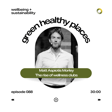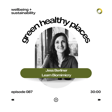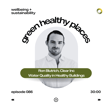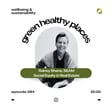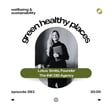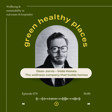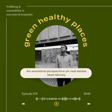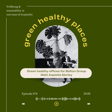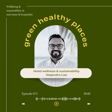Become a Creator today!Start creating today - Share your story with the world!
Start for free
00:00:00
00:00:01

Wellness interior design & neuroaesthetics
Welcome to episode 074 of the Green Healthy Places podcast in which we discuss the themes of wellbeing and sustainability in real estate and hospitality.
I’m your host, Matt Morley, and this week I’m in Denver, Colorado talking to Angela Harris, CEO an Principal of TRIO.
Angela is an American interior designer, product designer, industry board member and she has a Masters in Sustainable Design.
She’s been building TRIO over the past 25 years or so and her team now designs everything from master planned communities, to commercial, hospitality and residential developments.
GUEST:
- https://triodesign.com/
- https://www.linkedin.com/company/designbytrio/
- https://www.byangelaharris.com/
- https://www.bodeandwell.com/
HOST:
- https://www.greenhealthyplaces.com/
- https://www.linkedin.com/in/mattmorleylux/
Transcript
Introduction to Episode 74
00:00:02
Speaker
Welcome to episode 74 of the Green Healthy Places podcast, in which we discuss the themes of wellbeing and sustainability in real estate and hospitality.
Interview with Angela Harris from Trio
00:00:12
Speaker
I'm your host, Matt Morley, and this week I'm in Denver, Colorado, talking to Angela Harris, CEO and principal of Trio. Angela is an American interior designer, product designer, industry board member, and has a master's in sustainable design.
Building Trio: 25 Years of Design
00:00:28
Speaker
She's been building Trio over the past 25 years or so, and her team now design everything from master plan communities to commercial hospitality, residential developments, and much more, as we'll see. So Angela, welcome to the podcast. Thanks for being here. Thank you so much. Thank you for having me. I'm excited. Can you give us a quick intro then to the Trio business as you would describe it, what the business looks like today, the different services that you offer?
00:00:55
Speaker
Absolutely. So we manage a portfolio of brands. And one of those brands is Trio. And Trio Services, the builder and developer market, they have for over 23 years. And really, we're tasked with new community development. So you say there's the portfolio with the other brands then. And so how have you structured that in terms of the
00:01:22
Speaker
partner brands you've also developed or the sub brands. How is that? How do you see that architecture?
Trio's Holistic and Intentional Design Approach
00:01:29
Speaker
Yeah, I think what we found through Building Trio is that we really wanted the opportunity to have a holistic perspective when it comes to the built environment. And so we branched off into a couple of different brands. We also have a brand that handles research and development.
00:01:46
Speaker
We do full service interior design for builders and developers through Trio. We have a luxury residential side of the business as well as product development. And that allows us to kind of look at our projects, again, specifically a new community development from a holistic perspective to reach our wellness and sustainability goals.
00:02:07
Speaker
So in a sense, you've kind of gone, if you see it as being quite vertically integrated, in a sense, the R&D sort of goes up one step like before the work is done and delivered at the building level and then another layer down, which is the actual sort of product that goes into the spaces you're designing those as well. So essentially, you've got these sort of three pieces that interconnect, right?
00:02:28
Speaker
Absolutely. It allows us to kind of look at a project from A to Z and really ensure that we're not tracing trends necessarily, but that we're really putting out intentional design that has a purpose.
Post-COVID Design Trends and Consumer Demands
00:02:42
Speaker
Yeah, it's very interesting the way you've done that. Excellent. And so we obviously connected via a project to do with sort of health and wellness in one of the community developments that you're currently working on. How and where and what type of development are you finding most success in implementing
00:02:59
Speaker
this sort of healthy interior design principle that you've become known for over the last decade or two? Yeah, it's an interesting question. And I get this question a lot because there's a lot of conversation in the market right now as it relates to health and wellness. And from our perspective, again, because we are a firm that doesn't like to chase trends necessarily, but to really look at things holistically,
00:03:22
Speaker
and really look at it from the user experience. We start with the research and development side of things so that we can stay on the forefront of that innovation. And we're talking about everything from sustainability to neuroaesthetics to health and wellness to everything so that we don't just compartmentalize the wellness conversation. I think it's one component of that.
00:03:46
Speaker
In that, I think what we're finding and where we have most success is the developers and the builders that are really open to the discussion or the conversation of having more dynamic spaces, spaces that provide experiences, spaces that engage the end user and the design process. I think that's where we're having the most success today. Well, I've seen that at work when you're able to bring an extra layer of depth, insight and
00:04:16
Speaker
rigor to the suggestions that the creative team are tabling for a developer. So there's a creative piece, there's the aesthetics, and then you're able to add this additional layer which is, and here's the why, here's how that works, here's how that functions, which is in a sense kind of explaining
00:04:36
Speaker
Well, you might intuitively sense once you eventually get into the space that you've designed, but for the developer who's having to essentially buy into the vision of that concept that you've designed, they're not there yet. And so adding that sort of explanation informed by research the way you do it really helps them, I guess, understand the why. Am I right? Absolutely. I think in an essence, it's really taking the design rationale to the next level.
00:05:04
Speaker
And with the technology that we use today, it's easy to articulate that vision and articulate the why behind the what or to validate that design rationale. And that's a very important component for us.
Beyond Greenery: True Biophilic Design
00:05:18
Speaker
You mentioned the term neuroaesthetics. I'm going to come back to that in a second, if I may. Just to go one question deeper on the healthy interiors.
00:05:28
Speaker
There's an awful amount of discussion at the moment around biophilic design. It's been, as you say, a hot topic for a while. You don't want to be following trends, nor do I think it really is a trend. I hope it's not. I hope it's just sort of here to stay. What about things like healthy materials? Are there any specific areas within the sort of umbrella term of healthy interiors where you're finding a lot of demand, perhaps post-COVID, if that's changing?
00:05:52
Speaker
from year to year or if it's more of a, you've established a certain number of sort of core fundamentals within a wellness interior and they're all being adopted and embraced by developers or if they're coming to you perhaps with a specific request that you're seeing in the market at the moment. Yeah, I mean, I think that we've been very fortunate over the last several years that our manufacturers have really tied into this same vision of health and wellness and sustainability.
00:06:20
Speaker
I think they've done an exceptional job at sourcing those products, whether it be natural materials or whether they're going to introduce an engineered product to the market, that they're really doing the due diligence behind that engineering to make sure that there's very low toxicity or no toxicity in those materials. And so I think our manufacturers have done a really great job at keeping up with consumer demand, and that makes our job a lot easier.
00:06:47
Speaker
I think we continue to hone in on that as it relates to biophilia and the beginning of that question. I think biophilia is a very important conversation and I'm glad that it has reached the surface of the market where we are seeing market demand on the consumer side of that. And I now think it's part of a piece of education because biophilia not only ties into sustainability attributes, it also ties into neuroaesthetics.
Neuroaesthetics and Interior Design
00:07:12
Speaker
And I think there's a misunderstanding that biophilia comes with this really expensive green wall or that it's very expensive to do. And in reality, biophilic design has so much more to do with just the overall general connection to nature. So that encompasses things like natural light, natural materials, certainly natural greenery throughout the space to promote healthy air and oxygen levels and so forth.
00:07:41
Speaker
It's not just a matter of, I'm going to throw a whole bunch of life plans in my environment and say that I am designing around the principles of biophilic design. I think that there's more things that can be taken into consideration. Certainly, view lines, for example, and new community development becomes a very important conversation. And one that I think, to your point, I hope it is not a trend. I hope it's here to stay.
00:08:04
Speaker
It can sometimes feel almost as if it's about doing perhaps a bit less and letting nature do some of the work rather than over-designing a space, right? Sometimes there isn't need to do so much if there's enough nature around. So what is then the bridge between that? So say, for example, between biophilic design and that term that we've used a couple of times now of neuroaesthetics. For anyone who's perhaps unfamiliar with the term, what are the sort of key fundamentals of that concept as you see it?
00:08:34
Speaker
Well, it's funny that you say that because I couldn't agree with you more. I think what we need to continue the conversation on, especially when it comes to design is simplicity, authenticity, kind of downplaying the egotistical side that we have always seen historically in our industry and really playing up this idea of no delineation between site and structure or indoors and outdoors, for example.
00:09:02
Speaker
I think when it comes to neuroesthetics, a lot of those principles are being taken into consideration all the way from visual complexity to biophilic design to fractal patterning and color. I think those are all important touch points, but I am hopeful. And in fact, one of the research projects we're doing right now is to kind of validate that kind of direction in our industry where it really is more about simplicity and celebrating the natural environment in which we live in.
00:09:31
Speaker
And so, for example, with the new aesthetics piece, is that something you lead on with a client or is it something that you sort of keep in your back pocket? You know, is a developer buying into that? Is the developer taking that concept forward and rolling it out even, let's say, as part of their concept that's then communicated out to the end client? Or do you think this is just something that informs your approach and brings a whole heap of benefits, but that isn't necessarily something that the developer
00:10:01
Speaker
and their marketing team talk about in the end result? I think it's a combination of both. And so what I mean by that is it's certainly something that we have adopted in our firm as part of our core values and our design philosophy. And I think it starts there because, you know, the designers that we have in house are incredibly talented designers. And if we don't believe in what we are designing or putting out to the market, I think we have a fundamental breakdown from the beginning.
00:10:30
Speaker
we try to adopt this design philosophy in our core values and how we approach projects on the onset. Now, part of that, the other side of that coin is obviously understanding our clientele. And our clientele are builders and developers and they're a very unique audience. And what I mean by that is what I have found being, again, being in this industry for 23 years is there's no better group out there that cares more about our communities and developing amazing communities where people can thrive.
00:10:59
Speaker
They need to balance that with a capitalism system. And I think it's one of those things where it is always a tricky balance. But what we have found is they are absolutely open to the discussion as long as we can balance it with the budget, right? And as long as we can balance it with the limitations in which we have to get these projects out off the ground and into the market. And certainly the conversation of simplicity and more intentional design and those conversations
00:11:29
Speaker
go a long way on both sides of that coin.
Social Connections in Community Design
00:11:32
Speaker
I presume it's also to some extent or can be used as a unique selling point for the development, right? So you're also adding this additional health benefit in a sense. But you've mentioned community a few times. It's a word sort of buried within it, obviously. It's a social component. And I think so often buildings are becoming
00:11:55
Speaker
you know, signs of the cultural zeitgeist and there's so much happening at the moment around social connection and its importance in mental health and wellbeing. So I wondered, you've obviously dealt with so many of these over the years, but the way you're approaching community developments now, I know you're doing, for example, active adult developments around the US, how do you go about
00:12:15
Speaker
leveraging your research and design component and creating a sense of community, not just building a development that is labeled the community, but actually fostering those social connections. Are there things that you've been able to pick up tools of the trade to do that that can facilitate actual connections happening once this thing is launched and the residents move in?
00:12:38
Speaker
Yes, and it's a very important conversation because I think that it's one of the conversations that get missed in the whole health and wellness dialogue and that is the social component of it because research has shown that that social component drives so much of the mental health component that you just mentioned.
00:12:58
Speaker
In my mind, again, it starts with what we believe in in terms of a design philosophy. And we truly believe that, yes, we are the creator, and we create these buildings or these built environments, but they in turn construct us. And what I mean by that is that what we design and what we build or what we bring to market will 100% influence our users
00:13:22
Speaker
culturally, socially, politically, and so forth. So those design decisions become even more critical.
Adapting Designs for Diverse Demographics
00:13:29
Speaker
So in order for us to be successful, not only do we have to tie into the vision of the developer, but a very important component is really understanding the operational guidelines that our communities are operating under, the programming that will be offered, so that we can design to that programming. And again, I think it's a really important piece to connect those dots
00:13:50
Speaker
in order to have a successful execution that can come to market. So there's clearly a difference in those concepts then around how you're designing, say, something for an active adult community to, say, a multi-family. And is that largely to do with, you mentioned programming, is it then specific facilities that a developer is asking you to incorporate? How do you split those apart and then target something specifically for the active adult community in the US at the moment?
00:14:20
Speaker
I think it starts with understanding the demographics, certainly understanding the psychographics and understanding how the values have changed within those psychographics and demographics. And they certainly are changing on the 55 plus side. Again, we are highly embracing a wellness position in those particular projects. And it's not only from the interior perspective, but it's from the outside perspective. So on the onsite of a project,
00:14:49
Speaker
We study the site just as much as we study the interior environment and I think that that's very important because at the end of the day these projects are a meeting of the minds between multiple disciplines and frankly as I mentioned on the onset of the conversation the user experience and the operators in which these clubs or these communities are being executed. There are very important
00:15:12
Speaker
feedback loop in terms of the design process. So it can't just be about the creator, but it also has to be about the created or the user experience or the people operating the facility along the way. And I also think that we have to start. We have to not have the conversation in a compartmentalized manner. You know, historically, it's always been, well, this is our social club and this is our fitness club and this is our art club.
00:15:38
Speaker
And in reality, the whole entire experience needs to be looked at in a more holistic perspective, and that's what we're starting to see now.
Sustainability as a Core Design Value
00:15:48
Speaker
So the wellness piece, the health and wellness piece is interesting because it's something that the end user, so the resident, can connect with and benefit from. The sustainability piece
00:16:01
Speaker
perhaps less so, or rather in an indirect way. So are there specific, are you finding there are bigger hurdles to pushing the green message with your clients? Is there nowadays a wider acceptance that this is just something that needs to be part of the mix? Perhaps they're going for elite certification, interior design, perhaps not. Are you finding it's now
00:16:26
Speaker
an obligatory piece? Is it something that's optional, perhaps, you know, bathed into the corner if the budgets are coming in too tight? How are you seeing that now? And has it shifted in recent years? Yes, it has shifted over recent years. And we're still having the conversation, especially in new community development, whether that piece of the puzzle is valued by our consumers or not.
00:16:52
Speaker
And the way that I answer that generally with my clientele is that it really doesn't matter. What matters is that as a design professional profession that is actually working in the realm of new community development, we have an obligation to design communities where people can thrive and where they can live their best lives and live their healthiest lives. And so a large part of that comes through our
00:17:18
Speaker
core values and our design philosophies and the design decisions in which we are making. And so I sleep better at night knowing that I can take that position and say, hey, this is just who we are. And no longer is it a choice, but this is this is what we do as a design firm. Do you feel that there is no
00:17:38
Speaker
a clear change from how things used to be where it did feel like sustainable interiors sort of had a specific style right there just wasn't enough there weren't enough options on the market and so a lot of eco design sort of looked like eco design do you think we've left that era behind and you have enough choice now that you can pretty much design spaces and
00:18:02
Speaker
integrate these things without them necessarily being chosen for their sustainability, but this can be an aesthetic choice. And by the way, this is also a low impact or circular material. Have you reached that point or is there still a way to go in that process, do you think, where you have enough of everything that you need to roll out a sustainability plan almost without it being the raison d'etre of the project, but you have enough options on the market available? 100%. I think that sustainability has
00:18:32
Speaker
definitely become mainstream. I think what our consumers have gone through in the last several years has accelerated that. I think that there are several choices in the market to make better design choices, whether you're an architect or a designer or a landscape architect. There's plenty of products out on the market for us to select from that both have sustainability, wellness, and even neuroacetic components to it.
00:18:58
Speaker
I think that our consumers walk into a space and they may love it or they may hate it. But when they walk into that space, a lot of times they don't even know how sustainable it is or that it's been designed around neuroaesthetic design principles. All they know is that it feels really good. And that's when we've done our job.
Non-Toxic and Aesthetic Product Strategies
00:19:16
Speaker
Yeah, that's the magic, right? That's when it all comes together. Right.
00:19:21
Speaker
You mentioned the idea of developing products, working with manufacturers. I wondered if the strategy there had been about, I guess this is the connection between the previous question and this one, but is there a sense of, oh, you could see that there was a gap in the market. No one was, you couldn't find a particular product and you decided to go out and sort of fix it by manufacturing something yourself to fill that gap. Or has it been more of an organic process of sort of things that came out of projects that you've then
00:19:51
Speaker
moved into production. How have you gone about creating that little collection of products on the side? That was definitely an intentional strategy on our end. I think what we were seeing in the market, you know, we do over 300 projects a year at Trio and we were running into a challenge of finding very mainstream product that was full of toxicity, couldn't reach the goals in which we were trying to accomplish. And so really the question became,
00:20:21
Speaker
you know, how do we start designing some collections that are aesthetically pleasing that tie into these principles that are artful in their intention and non-toxic? And I think there's a real niche in the market for that right now. I think the industrial revolution changed a lot, as we all know, in terms of how our built environment is manufactured, how our products are manufactured. There's a lot of things hitting the market that just
00:20:48
Speaker
you know, it's just mass-produced, frankly. And we need to move away from that. I always wonder how widely accepted that concept is. I think for those of us close to the industry or in it, looking from the inside out, we know enough about the toxicity of certain materials and chemicals that have found a way into furniture that might be in bedrooms at home.
00:21:15
Speaker
um or in our offices but I wonder do you think that message is is out fully or is there still more work to be done around educating the wider market do you think slowly it's trickled through or is there still work to be done around perhaps education is is too strong a word but communicating the message of of let's say risks essentially right from toxic materials and and furniture and
00:21:40
Speaker
paints and finishes that find their way into our interiors? Or do you think people have started to trigger onto that if they're remotely involved in the real estate industry now? No, I think there's a lot more work to be done. I think that we have started to see changes in our market. We certainly have started to see value shift in our consumers, whether they're really connecting the dot in terms of, hey, I want to tie into health and wellness.
00:22:09
Speaker
but yet I'm sleeping in a bed that's highly toxic. I'm not sure that connection has been made yet. I'm not sure that we have a complete commitment from, you know, some of our major manufacturers on what it means and the importance of not only non-toxic products, but also aesthetically pleasing products. I mean, the aesthetics play such an important role as well.
00:22:33
Speaker
And so how do we balance the triangle of aesthetics, non-toxicity and price points or capitalism? And I think the conversation of how to bridge those gaps and connect those dots are going to be the people and the manufacturers and the designers that really thrive in the next 10 years.
Future of Design: Neuroaesthetics and AI
00:22:57
Speaker
Well, kudos to you for having made that bold move into making the products and literally putting your money where the mouth is and showing how it's done. It's kind of been easy. I'm sure it wasn't moving from interiors into products. It can't be an easy process. But congrats on what you've done. It's been a fascinating conversation. But please, what's next? Where do you go from here when you look down the
00:23:20
Speaker
on the pipeline of the next three to five years, where do you go from here? Do you just go deeper into the sectors that you've already started mining, or are there other fields, other spaces that you'd like to move into? First of all, thank you so much for your kind words. I do have to say, none of this is possible without the incredible team over here at Trio. We make a really dynamic team, and that's how we're able to accomplish so much. And I think what's next for us is really
00:23:49
Speaker
you know, a deeper dive into neuroaesthetics. I think we want to continue to do the research and development. We certainly have made that commitment for the next five years. We have made a commitment to understanding visual arts and neuroaesthetics as it relates to the built environment specifically. And we intend to bring that education to market and to speak on panels and so forth about the importance of that.
00:24:15
Speaker
Um, so I think we're going to continue. I know we're going to continue down that path and we'll continue integrating that and penetrating that with, you know, in our own design work here at trio. And, you know, we're also starting to talk about AI, which is really exciting for us. Um, and so we will dive deeper into that and certainly in the next five to 10 years as well. And I think that it's going to make a big shift in how we design what we're bringing to market and how we're educating the consumer and that messaging to market certainly
00:24:45
Speaker
in the next few years.
Conclusion and Contact Information
00:24:48
Speaker
Awesome. Fantastic. Well, we'll link to the three websites, triodesign.com, biangelaharis.com, and thodunwell.com in the show notes. In terms of social media, what's your preferred channel? You know, we have trio design and then we also have biangelaharis, so both of them work. Cool. Awesome. Well, listen, thanks again. It's been great. Thank you so much.

